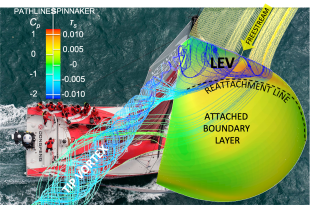Our research focuses on the aerodynamics of yacht sails. Sails are thin, flexible wings that operate in a highly turbulent flow. Their sharp leading edge promotes flow separation, which is a unique feature of sails between high-performance wings. A review of sail aerodynamics is given by Viola 2013. In some conditions, flow separation results in the generation of a turbulent shear layer that attaches further downstream, forming a leading-edge separation bubble, while in some occasions, it forms a stable leading-edge vortex similar to that of delta wings (Souppez et al., 2019). Our recent research has focused on understanding the underlying force generation mechanisms of sails and on the force contribution of vortical flow structures in separated flow regions (Arredondo-Galeana et al. 2023; Souppez and Viola, 2024).
Find here a set of experimental and numerical benchmarks for both upwind and downwind sails:



